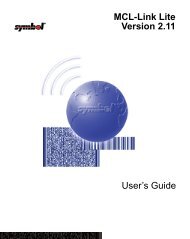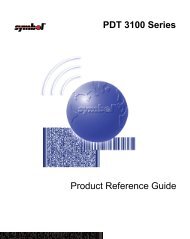PDT 6800 Series Product Reference Guide
PDT 6800 Series Product Reference Guide
PDT 6800 Series Product Reference Guide
You also want an ePaper? Increase the reach of your titles
YUMPU automatically turns print PDFs into web optimized ePapers that Google loves.
Chapter 4<br />
Spectrum24 RF Terminal Setup<br />
Spectrum24 Terminals<br />
In Spectrum24 terminals, wireless connectivity is accomplished using standard<br />
communications protocols. Because they are standard, the protocols are generalized and take<br />
up considerably more space on the terminal’s NVM than is required for Spectrum One ®<br />
terminals. Because there is less space available in NVM for application files, the terminal<br />
operates with an additional megabyte of non-volatile memory or flash disk. This extra<br />
memory is used to reduce not only the boot times but also the time and resources required to<br />
load applications into the terminal. The flash disk also offers the possibility of running<br />
multiple applications from the same terminal (refer to the Spectrum24 Setup and Utilities<br />
<strong>Reference</strong> <strong>Guide</strong> p/n 72-50795-01 for more information). With version 3.03 or later of the<br />
system software (LWP.HEX), the terminal can also run diagnostic tools.<br />
Accessing the Flash Disk<br />
The flash disk is accessed through a driver, FLASHDSK.SYS, which makes the flash disk<br />
appear to a program as another disk drive (E:). The drive has characteristics of fast reading<br />
but slow writing (for example, even for the smallest files, the write process takes 3-4 seconds).<br />
These characteristics make it ideal for files that are written once, accessed often, and seldom<br />
updated.<br />
We recommend that you use the flash disk (E:) mainly for application and configuration file<br />
storage. It is important to note that because of the slow writing time (3-4 seconds), writing<br />
files during a power interruption (low battery, dead battery, suspend, power off, or power<br />
failure) could corrupt the disk. Be sure to only write data to the disk with the terminal<br />
connected to external power or with the battery fully charged to avoid problems. To avoid<br />
overwriting the flash disk by mistake, the flash disk is set to read-only mode for normal<br />
4-1



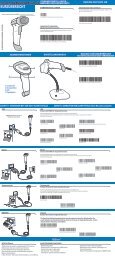
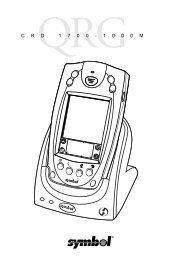


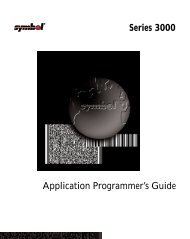

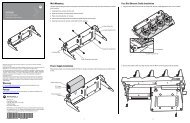

![MC55 Regulatory Guide [Spanish] (P/N 72-108860 ... - Enterprise](https://img.yumpu.com/14574395/1/190x133/mc55-regulatory-guide-spanish-p-n-72-108860-enterprise.jpg?quality=85)
![ES400 Regulatory Guide [Spanish] (P/N 72-134312-01ES Rev. A)](https://img.yumpu.com/14415156/1/190x127/es400-regulatory-guide-spanish-p-n-72-134312-01es-rev-a.jpg?quality=85)
![MC35 Regulatory Information [Spanish] - Symbol](https://img.yumpu.com/14415086/1/190x143/mc35-regulatory-information-spanish-symbol.jpg?quality=85)

